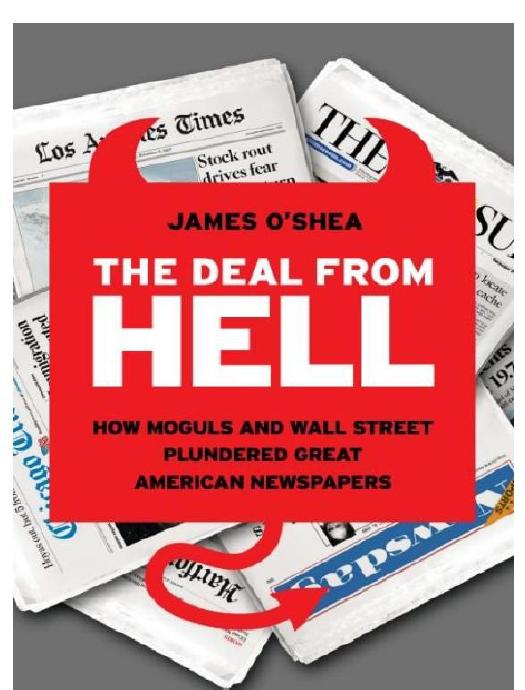The Deal from Hell by James O'Shea

Author:James O'Shea
Language: eng
Format: epub, pdf
Publisher: PublicAffairs
Published: 2011-05-23T16:00:00+00:00
Puerner, who had gone to work for Tribune Company fresh out of college, saw the decline in revenues that had decimated classified advertising start to infect display ads—the kind that the Hollywood studios in the Times’ backyard ran to trumpet their latest films and the kind that big department stores ran. To prosper, he thought the Times had to generate unique content to justify a higher newspaper cover price and a fee for Internet access, a method known in the industry as paid content. Puerner didn’t think the Los Angeles Times could succeed by providing better local news coverage than the Long Beach Telegram: “There was just no way that you could out Long Beach, Long Beach. I looked, and in every market where we tried to do that, we were number two.... You had to look at the big topic areas—public safety, health care, the huge issues the Times was uniquely positioned to cover.”
But investing editorial resources to provide superior coverage meant building up the expensive foreign, national, and business news staffs, a strategy that the Kerns and FitzSimons of the world strongly opposed. They knew cutting prestigious foreign and national news staffs set editors’ teeth on edge, but they were counting on the reductions to generate costs savings. “Jack [Fuller] and I didn’t agree. We had long, honest conversations about this. But he was the buffer,” Puerner said, “he was a big buffer. When he left, there was increased corporate presence in Los Angeles. Frankly it made things more difficult for us to manage.... It became clear that our philosophy collided with the need in Chicago to cut costs . . . and that these two differences in philosophies were irreconcilable.” Puerner left the Times in May 2005, and Jeffrey Johnson, another Tribune veteran and smart executive who had earned his stripes reducing the cost of the Times’ backward production process, filled the publisher’s seat. FitzSimons had effectively placed people with little publishing experience at the helm in Los Angeles, Chicago, and New York, his three largest properties and the source of more than half of the company’s revenues. And then there was a whiff of a rumor—this time about the Times’ circulation numbers.
Newsday had gotten newspaper executives around the country to take stock of the risks involved in lying about the numbers. In July 2002, Congress added to the industry’s woes by passing the Sarbanes-Oxley Act, which mandated that top corporate officers sign off on the accuracy of all internal reports. Congress also had passed legislation creating a “do not call” list, which hurt newspapers’ phone circulation sales. And then there was the Internet—a fabulous, fast, free alternative to delivering news and advertising to hordes of willing readers.
As newspapers began to look inward, the Dallas Morning News and the Chicago Sun-Times preempted the Banars of the world by publicly announcing they had discovered bogus circulation—announcements that triggered internal investigations, scrutiny by ABC, and more headlines. Many of the industry’s circulation chiefs started to squirm. Newspapers had to
Download
This site does not store any files on its server. We only index and link to content provided by other sites. Please contact the content providers to delete copyright contents if any and email us, we'll remove relevant links or contents immediately.
Autoboyography by Christina Lauren(4691)
Asking the Right Questions: A Guide to Critical Thinking by M. Neil Browne & Stuart M. Keeley(4620)
Dialogue by Robert McKee(3606)
Eat That Frog! by Brian Tracy(3544)
Sticky Fingers by Joe Hagan(3465)
Journeys Out of the Body by Robert Monroe(3013)
Elements of Style 2017 by Richard De A'Morelli(2952)
Annapurna by Maurice Herzog(2856)
Schaum's Quick Guide to Writing Great Short Stories by Margaret Lucke(2818)
Full Circle by Michael Palin(2791)
The Diviners by Libba Bray(2455)
The Art of Dramatic Writing: Its Basis in the Creative Interpretation of Human Motives by Egri Lajos(2425)
The Mental Game of Writing: How to Overcome Obstacles, Stay Creative and Productive, and Free Your Mind for Success by James Scott Bell(2403)
Why I Write by George Orwell(2375)
Atlas Obscura by Joshua Foer(2359)
In Patagonia by Bruce Chatwin(2286)
The Fight by Norman Mailer(2166)
The Elements of Style by William Strunk and E. B. White(2081)
Venice by Jan Morris(2062)
